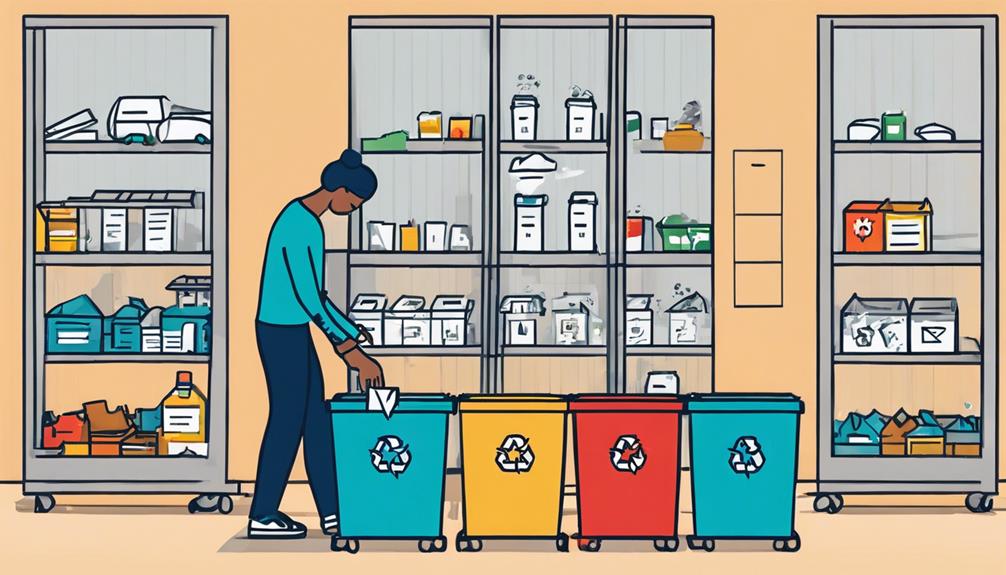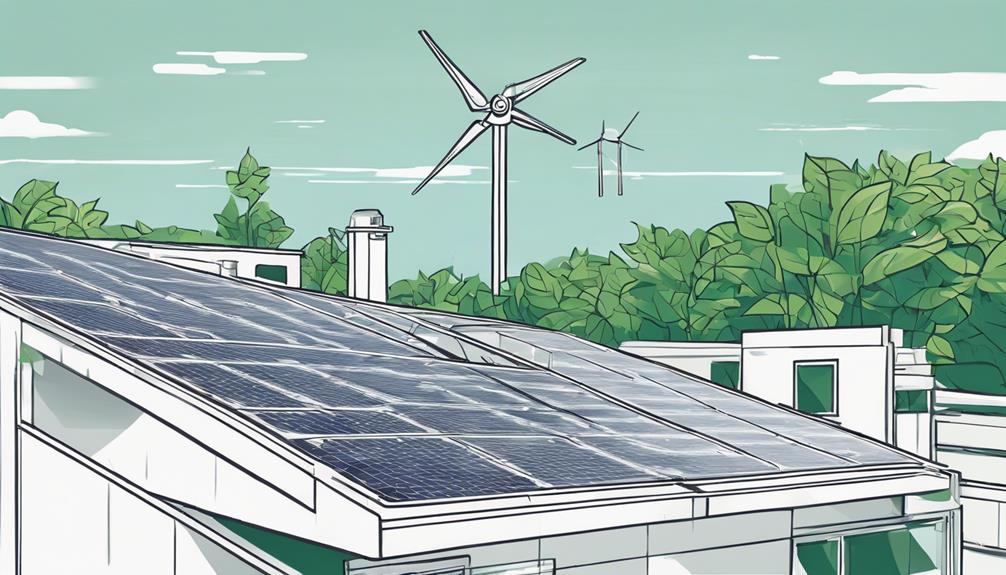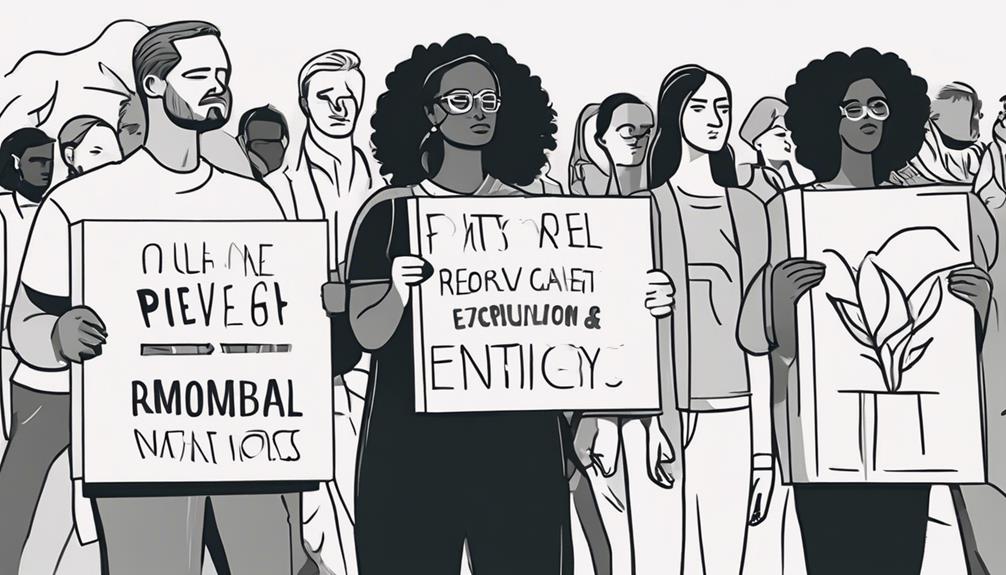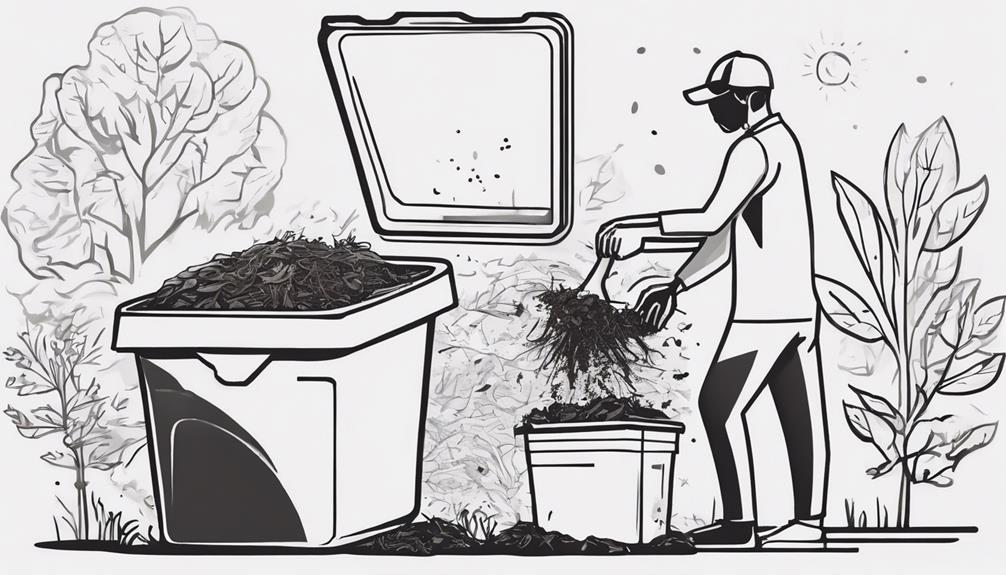Achieving sustainable living is a multi-faceted endeavor that requires a systematic approach and a fundamental shift in our daily practices. By focusing on sustainable food choices, eco-friendly transportation options, energy-efficient home practices, and minimalist living, individuals can contribute to a more sustainable future. However, the path to sustainable living is not without its challenges. It necessitates a deeper understanding of our environmental impact and a commitment to change. In examining the intricate web of sustainable living practices, we uncover a world of possibilities that can lead us towards a more harmonious coexistence with our planet.
Key Takeaways
- Embrace plant-based diets and reduce food waste for a sustainable lifestyle.
- Opt for renewable energy sources like solar and wind power.
- Advocate for environmental policies and support wildlife conservation efforts.
- Choose sustainable travel options and promote green infrastructure and education.
Sustainable Food Choices

Making sustainable food choices is essential for reducing environmental impact and promoting a healthier planet. Embracing plant-based diets is a significant step in this direction. The production of meat is resource-intensive and contributes substantially to environmental degradation through deforestation, water consumption, and greenhouse gas emissions. By opting for plant-based foods, individuals can lower their carbon footprint and help mitigate climate change.
Additionally, addressing food waste is crucial in achieving sustainable food practices. Nearly 40% of edible food in the US is wasted, leading to unnecessary resource depletion and environmental harm. Preventing food waste through smart shopping practices, proper storage, and consuming what is purchased can significantly reduce the environmental impact associated with food production and disposal.
Eco-Friendly Transportation Options
Eco-friendly transportation options offer significant benefits in reducing greenhouse gas emissions and promoting sustainable living. Electric vehicles contribute to cleaner air quality by producing zero tailpipe emissions, while public transportation systems play a crucial role in cutting down millions of metric tons of greenhouse gases annually. Additionally, choosing cycling or walking for short trips not only emits zero greenhouse gases but also fosters healthier and more sustainable urban environments.
Electric Vehicles Benefits
Transitioning to electric vehicles presents a compelling solution for reducing air pollution and greenhouse gas emissions, thereby promoting a more sustainable transportation infrastructure. Electric vehicles (EVs) produce zero tailpipe emissions, significantly lowering the carbon footprint and combating climate change. They are also more energy efficient than internal combustion engine vehicles, converting up to 60% of the energy compared to around 20% for gasoline vehicles. The cost of charging an EV is notably lower than fueling a gasoline vehicle, leading to cost savings and reduced reliance on fossil fuels. Moreover, EVs have lower maintenance costs due to simpler drivetrains, ensuring long-term savings for owners. By embracing electric vehicles, we can actively contribute to a cleaner, greener future while enhancing overall sustainability in the transportation sector.
Public Transport Advantages
Utilizing public transportation systems offers a myriad of advantages, particularly in the realm of eco-friendly transportation options. Public transport plays a crucial role in reducing greenhouse gas emissions, with the potential to decrease up to 37 million metric tons annually in the U.S. On an individual level, using public transportation can save over 4,800 pounds of greenhouse gas emissions per year, making it a sustainable choice for daily commuting. Moreover, public transit helps alleviate traffic congestion, saving commuters in large cities up to 111 hours per year. By opting for public transport over personal vehicles, individuals can contribute to lowering air pollution levels and enhancing overall air quality. Additionally, public transportation systems spur economic growth, providing $4 in economic returns for every $1 invested.
| Advantages of Public Transport | ||
|---|---|---|
| Reduces greenhouse gas emissions | Saves individuals over 4,800 lbs of emissions yearly | Alleviates traffic congestion |
Cycling for Sustainability
Cycling as a sustainable transportation mode offers a zero-emission solution that contributes significantly to reducing air pollution and combatting climate change. By choosing biking over driving, individuals can actively participate in reducing carbon emissions, thus promoting a more sustainable environment. Apart from its environmental benefits, cycling also presents economic advantages by saving on fuel costs and promoting physical health through exercise. Additionally, the shift towards cycling can alleviate traffic congestion, leading to a more efficient transportation system. Investments in cycling infrastructure have shown positive outcomes, including boosting local economies, enhancing public health, and creating safer streets for all road users. Encouraging cycling as a transportation choice not only aids in reducing carbon footprints but also fosters community connectedness and improves overall quality of life in urban areas.
Energy-Efficient Home Practices
Implementing energy-efficient home practices is crucial for reducing overall energy consumption and decreasing utility costs. By adopting simple yet effective measures, households can significantly lower their environmental impact and save money in the long run. One way to achieve this is by using a programmable thermostat, which can save up to 10% on heating and cooling costs. Sealing air leaks in your home is another impactful practice, potentially saving up to 20% on heating and cooling bills. Choosing clean energy suppliers for electricity not only reduces carbon emissions but also supports renewable energy sources. Additionally, installing rooftop solar panels can generate clean energy and lead to substantial reductions in electricity bills. Weatherizing your home through insulation and energy-saving lightbulbs further enhances energy efficiency. The table below summarizes these energy-efficient practices:
| Energy-Efficient Home Practices | Benefits |
|---|---|
| Use programmable thermostat | Save up to 10% on heating and cooling costs |
| Seal air leaks | Save up to 20% on heating and cooling bills |
| Choose clean energy suppliers | Decrease carbon emissions, support renewables |
| Install rooftop solar panels | Generate clean energy, reduce electricity bills |
| Weatherize home | Enhance energy efficiency with insulation and energy-saving lightbulbs |
Minimalist and Zero-Waste Living

Embracing minimalist and zero-waste living practices is crucial for reducing our environmental footprint and promoting sustainability. By decluttering possessions, focusing on reusable products, and minimizing packaging waste, individuals can significantly decrease their consumption habits. Choosing quality over quantity and adopting eco-friendly habits in various aspects of life are essential steps towards achieving a more sustainable and environmentally conscious lifestyle.
Reduce Consumption Habits
Adopting minimalist and zero-waste practices in daily living can significantly reduce environmental impact and promote sustainability. By embracing reduce consumption habits and Zero-Use Plastic initiatives, individuals can substantially decrease waste production and minimize their carbon footprint. Minimalist living encourages intentional consumption, leading to less accumulation of unnecessary items, hence reducing overall consumption levels. Zero-waste living focuses on diverting waste from landfills, with the average American generating 4.4 pounds of trash daily. Repairing items instead of replacing them not only decreases waste but also saves up to 10 million tons of CO2 emissions annually. Embracing these practices can also result in significant cost savings, with the average person potentially saving around $1,500 per year by avoiding unnecessary purchases.
Embrace Sustainable Practices
Incorporating sustainable practices such as minimalist and zero-waste living into daily routines is paramount for reducing environmental impact and fostering long-term sustainability. Here are three key ways to embrace sustainable living:
- Embrace minimalist living: Declutter and own only what you need to reduce consumption and waste, thereby lowering your environmental footprint.
- Practice zero-waste living: Minimize single-use items and opt for reusable alternatives to lessen environmental impact and promote sustainability.
- Choose sustainable transportation: Opt for walking, biking, or using public transport to reduce your carbon footprint and support eco-friendly modes of travel.
Community Garden Initiatives
Community garden initiatives play a crucial role in promoting sustainable living practices within urban communities by fostering local food production and environmental stewardship. These gardens provide access to fresh, locally grown produce, thereby reducing the need for long-distance transportation and cutting down on associated carbon emissions. Additionally, community gardens create a sense of camaraderie, cooperation, and shared environmental responsibility among participants.
Moreover, these initiatives serve as valuable educational platforms, offering insights into gardening, composting, and other sustainable practices. By cultivating community gardens, urban areas also benefit from increased biodiversity, the creation of pollinator habitats, and overall improvements in environmental health. The presence of such green spaces in cities not only enhances the aesthetic appeal but also contributes to the well-being of residents by providing opportunities for outdoor activities and connecting them with nature. Community garden initiatives are a tangible and effective way to instill sustainable habits and values in urban settings.
Recycling and Waste Management Strategies

Implementing efficient recycling and waste management strategies is crucial for sustainable living. By reducing plastic usage, composting food scraps, and creatively reusing materials, we can significantly minimize our environmental footprint. Understanding the impact of our waste and actively participating in recycling efforts are key steps towards a more sustainable future.
Reduce Plastic Usage
Efficient plastic waste management practices are crucial in mitigating the environmental impact of plastic pollution, particularly in oceans where millions of tons of plastic accumulate annually.
Ways to Reduce Plastic Usage:
- Minimize Single-Use Plastics: Opt for reusable alternatives like water bottles, bags, and containers to reduce plastic consumption.
- Support Recycling Initiatives: Ensure proper disposal of plastic waste and support recycling programs to increase the percentage of recycled plastics.
- Promote Sustainable Packaging: Encourage businesses to use eco-friendly packaging materials and reduce excessive plastic packaging.
Composting Food Scraps
Composting food scraps plays a pivotal role in sustainable waste management practices by transforming organic waste into nutrient-rich soil amendments. By diverting food scraps from landfills, composting reduces methane emissions and enriches the soil, contributing to a circular economy. On average, food scraps constitute about 30% of household waste, highlighting the significant impact composting can have on waste reduction. Composting at home alone can save up to 60 pounds of organic waste per month from reaching landfills. Moreover, the decomposition process in composting generates valuable soil that enhances plant growth and diminishes the necessity for chemical fertilizers. Embracing composting of food scraps is a practical step towards sustainable living and environmental stewardship.
| Benefits of Composting Food Scraps | |
|---|---|
| Reduces methane emissions | Enriches soil |
| Diverts organic waste from landfills | Improves plant growth |
| Significant waste reduction strategy | Promotes sustainable living practices |
Reuse Materials Creatively
The practice of creatively reusing materials through recycling and waste management strategies is essential in fostering a sustainable approach to resource utilization and waste reduction. When it comes to reducing waste and conserving resources, recycling plays a vital role. Here are three key points to consider:
- Plastic Bottles: Reusing plastic through recycling not only prevents these bottles from taking up to 450 years to decompose in landfills but also reduces the need for new plastic production.
- Aluminum Cans: Recycling one aluminum can save a significant amount of energy, emphasizing the importance of recycling to conserve resources.
- Glass Recycling: Glass is infinitely recyclable without losing quality, making it a prime candidate for reuse strategies that benefit the environment in the long run.
Sustainable Fashion Alternatives

How can individuals transition towards more sustainable fashion choices in order to reduce the environmental impact of the clothing industry? One approach is to opt for second-hand clothing, which helps mitigate the carbon emissions associated with fast fashion. Embracing minimalism by focusing on quality over quantity can also reduce the demand for new clothing production. Supporting ethical fashion brands that prioritize fair labor practices, sustainable materials, and transparency in their supply chain is another crucial step. It's essential to educate oneself about sustainable materials such as organic cotton, hemp, and Tencel to make informed decisions while shopping for clothing. Additionally, avoiding greenwashing by researching brands and seeking certifications that guarantee sustainable and ethical practices is vital.
| Sustainable Materials | Fast Fashion |
|---|---|
| Organic Cotton | High turnover of styles and products |
| Hemp | Mass production leading to excessive waste |
| Tencel | Low-quality garments with short lifespans |
| Recycled Polyester | Exploitative labor practices in supply chains |
| Linen | Chemical pollution from dyeing processes |
Water Conservation Techniques
Implementing efficient water conservation techniques is essential for reducing water consumption and promoting sustainability in households and communities. By incorporating simple yet effective strategies, individuals can contribute significantly to water conservation efforts. Here are three key techniques to conserve water:
- Fixing Leaks and Utilizing Low-Flow Fixtures: Addressing leaks promptly and installing low-flow fixtures can collectively save up to 10 gallons of water per day per household. This small adjustment can lead to substantial water savings over time.
- Rainwater Harvesting for Outdoor Use: Collecting rainwater for tasks like watering plants or cleaning outdoor spaces can help reduce the demand on municipal water supplies. This practice not only conserves water but also promotes self-sufficiency in water usage.
- Shortening Shower Duration: Taking shorter showers can save a significant amount of water. For instance, a family of four can conserve up to 1,000 gallons of water per month by reducing shower times. This simple habit adjustment can have a notable impact on overall water consumption.
Green Energy Solutions

Renewable energy sources such as solar, wind, and hydropower offer promising solutions for sustainable electricity generation. Solar power presents the potential to significantly contribute to global electricity needs, while wind energy stands as a leading renewable energy source in the U.S., capable of powering millions of homes. Additionally, hydropower and geothermal energy provide reliable and eco-friendly alternatives that can help reduce carbon emissions and promote a greener future.
Solar Power Benefits
Solar power emerges as a vital component of sustainable living due to its renewable nature, minimal greenhouse gas emissions, and long-term cost-effectiveness. When considering solar power benefits:
- Renewable Energy Source: Solar panels harness the sun's energy, which is abundant and inexhaustible, ensuring a consistent and sustainable energy supply.
- Cost-Effective Solution: Despite the initial investment, solar panels can last for 25 years or more, leading to significant savings on electricity bills over their lifetime.
- Environmental Impact: By using solar energy, individuals reduce their carbon footprint, contributing to a cleaner environment and mitigating climate change effects.
Wind Energy Options
Wind energy stands as a prominent green energy solution, offering a renewable and environmentally friendly alternative to traditional power sources. Harnessing wind through turbines to generate electricity, wind power is a clean option that significantly reduces greenhouse gas emissions and air pollution. The United States leads in wind energy capacity, boasting over 120,000 wind turbines nationwide. These turbines can be strategically placed onshore or offshore, providing sustainable energy solutions for various communities. By opting for wind energy, you can reduce your carbon footprint and contribute to combating climate change. Wind energy has the capacity to power numerous homes and businesses while helping to mitigate the impacts of climate change.
| Advantages of Wind Energy | |
|---|---|
| Renewable Resource | Clean Energy Option |
| Reduces Greenhouse Gases | Mitigates Pollution |
Eco-Friendly Electricity Choices
When considering sustainable electricity options, it is essential to explore a range of eco-friendly choices beyond the conventional grid-powered sources. Green energy solutions offer a promising pathway towards reducing environmental impact and promoting a more sustainable future. Here are three key eco-friendly electricity choices:
- Solar Power: Utilizing solar panels to harness energy from the sun is a clean and renewable way to generate electricity.
- Wind Energy: Wind turbines convert wind into electricity, providing a sustainable alternative to fossil fuels.
- Hydropower: Harnessing the power of flowing water through dams and turbines can generate electricity without producing harmful emissions.
Embracing these green energy options can significantly contribute to mitigating climate change and fostering a more environmentally conscious society.
Advocating for Environmental Policies

Advocating for environmental policies that address key issues such as greenhouse gas emissions, renewable energy promotion, wildlife habitat protection, waste reduction, and sustainable practices across various industries is crucial for fostering sustainable living practices. By advocating for legislation that limits greenhouse gas emissions, we can combat climate change, a pressing global issue. Supporting policies that promote renewable energy sources is essential to reduce our dependence on fossil fuels, which are finite and contribute significantly to environmental degradation.
Legislation safeguarding wildlife habitats and biodiversity is vital for maintaining ecosystem stability and preserving the delicate balance of nature. By advocating for regulations that prioritize waste reduction, recycling, and composting, we can minimize our environmental footprint and move towards a more sustainable future. Furthermore, promoting initiatives that encourage sustainable practices in industries like agriculture, transportation, and construction is paramount for achieving long-term environmental sustainability. Through advocacy and legislation, we can drive meaningful change towards a more environmentally conscious society.
Promoting Local and Organic Products
Moving from advocating for environmental policies to promoting local and organic products aligns with the principles of sustainable living by emphasizing the importance of conscious consumer choices in reducing environmental impact. Supporting local farmers and choosing organic products offer significant benefits for both individuals and the planet:
- Reduced Carbon Emissions: Purchasing local products decreases the carbon footprint associated with transportation, contributing to lower greenhouse gas emissions and supporting the local economy.
- Healthier Soil and Biodiversity: Organic products are cultivated without synthetic pesticides or fertilizers, fostering healthier soil, promoting biodiversity, and reducing the risk of harmful chemical exposure.
- Sustainable Farming Practices: Buying organic foods supports sustainable farming methods that prioritize environmental conservation and long-term agricultural viability, ensuring a healthier food system for present and future generations.
Composting for a Greener Future

Composting plays a vital role in fostering environmental sustainability by diverting organic waste from landfills and contributing to the creation of nutrient-rich soil for plant growth. Through the decomposition process, composting helps reduce methane emissions that contribute to climate change while enriching soil with essential nutrients, promoting healthier plant growth, and decreasing the reliance on chemical fertilizers. Furthermore, composting aids in retaining moisture in the soil, leading to improved water retention and decreased irrigation requirements. This sustainable practice also contributes to a circular economy by recycling organic matter, closing the loop on food waste, and promoting environmentally friendly practices. Additionally, the creation of valuable humus during composting enhances soil structure, allowing it to sequester carbon from the atmosphere effectively.
| Benefits of Composting | |
|---|---|
| Diverts organic waste from landfills | Reduces methane emissions |
| Enriches soil with essential nutrients | Promotes healthier plant growth |
| Helps retain moisture in soil | Reduces irrigation needs |
| Contributes to a circular economy | Enhances soil's ability to sequester carbon |
Eco-Friendly Cleaning Products
The utilization of eco-friendly cleaning products underscores a commitment to environmental stewardship and human well-being through the use of natural, non-toxic ingredients. When considering eco-friendly cleaning products:
- Safer Ingredients: Eco-friendly cleaning products are made with natural ingredients, such as vinegar, baking soda, and essential oils, which are safer for both the environment and human health compared to the harmful chemicals found in conventional cleaning products.
- Biodegradability: Many eco-friendly cleaning products are biodegradable, meaning they can break down into harmless substances, reducing the impact on ecosystems and water sources. This characteristic makes them a more sustainable choice for cleaning needs.
- Promotion of Healthy Environments: Choosing eco-friendly cleaning products reduces exposure to toxins and chemicals in your living spaces, creating a healthier indoor environment for you and your family. By making the switch to these products, individuals contribute to sustainable practices and lessen the carbon footprint associated with cleaning activities.
Sustainable Travel and Tourism

Building on the principles of environmental stewardship and sustainable living demonstrated through the use of eco-friendly cleaning products, the focus now shifts to exploring sustainable travel and tourism practices. Sustainable travel plays a crucial role in reducing carbon emissions, especially considering that 95% of world transport relies on fossil fuels. Opting for alternative transportation methods such as public transport, walking, and cycling can significantly lower emissions and decrease air pollution caused by travel. By encouraging the use of alternative transportation, urban planning can be influenced to prioritize sustainability in travel initiatives. Additionally, supporting local businesses and engaging in leisure activities within one's community can help minimize the environmental impact of tourism. Extending stays, consuming local produce, and using reusable products while traveling are further steps that individuals can take to enhance sustainable travel practices. These efforts collectively contribute to a more sustainable and environmentally conscious approach to travel and tourism.
Supporting Wildlife Conservation Efforts
Supporting wildlife conservation efforts is essential for safeguarding the delicate balance of ecosystems and biodiversity in the face of escalating threats posed by human activities. Here are three key points to consider:
- Habitat Destruction: Human-induced habitat destruction, through activities like deforestation and urbanization, is a primary driver of wildlife population decline. Conservation efforts aim to protect and restore these habitats to provide safe spaces for wildlife to thrive.
- Species Extinction Risk: With over 1 million species facing the risk of extinction due to human activities, wildlife conservation plays a critical role in preserving the rich tapestry of life on Earth. By addressing factors like poaching, pollution, and climate change, conservationists work towards preventing irreversible losses in biodiversity.
- Illegal Wildlife Trade: The illegal wildlife trade not only threatens endangered species but also fuels criminal activities and undermines conservation efforts. Supporting initiatives that combat wildlife trafficking is vital in ensuring the survival of vulnerable species and maintaining ecological balance. By addressing these issues, we can contribute to a sustainable future where wildlife thrives in harmony with humans.
Frequently Asked Questions
How Can We Achieve Sustainable Lifestyle?
To achieve a sustainable lifestyle, individuals must adopt eco-friendly habits and support green initiatives. This involves making conscious choices such as embracing plant-based diets, reducing waste through composting, choosing energy-efficient appliances, and supporting sustainable fashion brands. Engaging in community sustainability projects and advocating for eco-friendly practices are crucial steps in promoting a sustainable lifestyle. By incorporating these practices into daily routines, individuals can contribute to a more sustainable future.
How Is Sustainability Being Achieved?
Sustainability is being achieved through the widespread adoption of renewable energy sources such as solar power, wind energy, and hydropower. Additionally, efforts focused on waste reduction are crucial in promoting sustainable practices. By transitioning to cleaner energy alternatives and implementing strategies to minimize waste generation, societies are taking significant steps towards achieving long-term sustainability. These actions symbolize a shift towards a more environmentally conscious and responsible approach to living.
How Do You Live Sustainable?
Living sustainably involves reducing waste and conserving energy. By embracing minimalism, choosing reusable alternatives, and supporting eco-friendly brands, individuals can lower their environmental impact. Prioritizing plant-based foods, local produce, and water conservation techniques further contribute to sustainable living practices. Conserving energy through efficient fixtures and habits also plays a vital role. Together, these actions promote a lifestyle that is both environmentally conscious and socially responsible.
How Are We Going to Achieve Sustainable Environment?
Transitioning to renewable energy sources like solar and wind power is paramount for achieving a sustainable environment. Implementing strict regulations on waste management practices and industrial pollution is essential. Embracing waste reduction strategies and investing in sustainable technologies can significantly mitigate environmental impacts. By prioritizing renewable energy and waste reduction efforts, we can pave the way towards a cleaner and healthier environment for present and future generations.
Conclusion
In conclusion, achieving sustainable living requires a collective effort to adopt eco-friendly practices in our daily lives. By making sustainable food choices, using energy-efficient transportation, reducing waste, and supporting conservation efforts, we can work towards a greener future. While some may argue that sustainable living is costly and inconvenient, the long-term benefits to the environment and future generations far outweigh any initial challenges. Embracing sustainable living practices is essential for a healthier planet.
